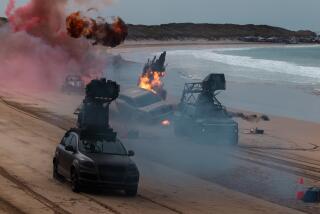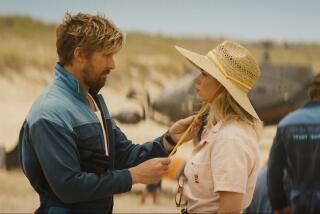Moon shots: Inside Ryan Gosling and Damien Chazelle’s key ‘First Man’ moments

“First Man” director Damien Chazelle guesses his movie about the Apollo 11 lunar mission spends about eight minutes on the moon and the balance of its 142-minute running time detailing the decade it took NASA and astronaut Neil Armstrong to get there.
“In terms of ratio, it’s not all that far off,” Chazelle says. He’s seated across from Ryan Gosling, who played Armstrong in the film, following his lead turn opposite Emma Stone in Chazelle’s celebrated 2016 musical “La La Land.” It’s late afternoon in a hotel restaurant on a winter weekday in Los Angeles. Chazelle keeps his fleece zipped, and Gosling methodically works his way through a pot of coffee. The two men share an easy rapport, feeling free to needle each other amid the mutual appreciation that comes from making back-to-back collaborations that found favor with critics and audiences.
“And you could argue all of it boiled down to the split second of the first footstep,” Chazelle continues. “That’s part of what’s poetic about the moon and the mission in general. So much time and resources went to get one footprint. And that one footprint is both one of the most minute things you can imagine committing a nation’s resources to get and yet one of the grandest accomplishments in history.”
Released in October, “First Man” has left theaters. But for an epic movie that was filmed partially in Imax 65mm, it possesses an intimacy that works beautifully on smaller screens. (“You gotta try it on the Apple Watch,” Chazelle jokes.) In part, that’s because “First Man” is just as interested in the everyday life of Armstrong and his family as it is in his singular determination to make it to the moon.
“The before and after of giant historical events,” Gosling says, “are the kind of ordinary things that both Damien and I love.”
The two men talked about both the grand and granular elements of “First Man,” zeroing in on some representative images from the film. Here are their thoughts.
Shortly before Armstrong left home for the Apollo 11 spaceflight, he sat down with sons Rick and Mark to answer any questions they might have. It wasn’t his idea. He did this at the insistence of his wife, Janet, played in the film by Claire Foy.
Gosling: This is probably my favorite scene in the film. The film is about many things, but the thing I connected most to was the love story between a family trying to find each other through all this grief and loss. Everyone’s in their corner, owning their seat at the table, trying to connect with this infinite void between them.
Chazelle: It’s definitely the scene we worked on the most every step of the way. It didn’t really exist in the first drafts of the script. We tried so many different things on set and then in the edit. I remember Ryan and [editor] Tom [Cross] and I just being in a room, playing with this scene alone for a whole day — and that was months after playing with it before.
Gosling: It was heavily improvised with takes where each person drove the scene. What makes me really happy is that Rick and Mark see it and felt it was accurate to what they remember. I’m not sure that happens. I’m just happy they felt it was truthful.
Chazelle: The scene lasts about two minutes. And it’s just people at a dinner table — simplicity itself. Rick and Mark vividly remember it for a lot of reasons, not the least of which was that they never used that table except for Thanksgiving. And of course, their dad sitting them down in this unusual way — unusual for him — to explain what was happening.
The astronauts’ space helmets featured a gold visor designed to protect them from solar radiation. It gave them a striking, almost alien appearance.
Chazelle: The gold visor is one of the most famous images of a human being in history, but you can’t see who the human being is. You don’t know what he’s thinking. You don’t know what he’s saying. You don’t even really know what he looks like. It speaks to Neil, someone who became an icon for everyone but no one really felt like they knew who he was. If we could get the audience inside that visor, that would be a way of showing people a side of this they haven’t seen.
Gosling: I can’t say enough about the suit. I highly recommend it. If you’re experiencing social anxiety, just get in the suit. You don’t have to talk to anybody. No one will talk to you.
Chazelle: There’d be a break for lunch or some technical difficulty, and we’d say, “Hey, Ryan, it’s going to be a while. You might want to change out.” And he’d be, “No. I’m good.” [Laughs]
Gosling: I loved it. I never wanted to get out of the suits or the capsules. There was something really peaceful about it.
How do you return to normalcy after walking on the moon? Gosling and Chazelle spent a lot of time ruminating on that question.
Chazelle: OK. This is going to sound strange …
Gosling: The fruit basket?
Chazelle: The fruit basket.
Gosling: We shot for half a day with that fruit basket. We were just so unsure how you would interact with that fruit basket after returning from the moon.
Chazelle: Ryan would play with one of the figurines. He ate an apple. There was a guitar in there at one point. We were just trying to find things. Because to walk into a room, fresh from coming to the moon, and seeing a fruit basket …. It’s funny. It lasts for 10 seconds, but it took us half a day.
Gosling: I don’t think that fruit basket gets enough credit for its performance in the film. And, by the way, it hasn’t done any press.
Chazelle: None.
Gosling: It didn’t come to the premiere.
Chazelle: It didn’t walk a single red carpet.
Gosling: I don’t even know why we’re giving it all this free publicity, frankly.
Space movies often have training sequences. “First Man” prominently featured the Multi Axis Trainer, a spinning device designed to simulate what it would feel like to tumble uncontrollably in outer space.
Chazelle: I remember the worry slowly mounting with Ryan doing more takes on the Multi Axis than I think anyone on set expected. But you never vomited — at least on set.
Gosling: You’ll never know. [Smiles] My only regret is that we didn’t get to do that vomit comet. It felt like a rite of passage in doing a space film. Still, I’m glad we went with this because it felt more suited to the things we were trying to focus on, which was NASA coming up with contraptions like that, taking stabs in the dark and doing everything humanly possible to predict the unknown.
After meticulously showing all the trials and many errors leading up to the Apollo 11 mission, filming Armstrong’s legendary walk affected both Gosling and Chazelle in ways that went deeper than they imagined.
Gosling: Doing this was definitely one of those moments when you wonder what happened in your life where you got to this point where you’re standing in a quarry in Atlanta doing the ‘one small step’ speech.
Chazelle: Right up until we began filming this, it didn’t feel like anything other than making a movie. You’re there and it’s 3 a.m., and you’re focused on making the day, getting a certain number of shots … and then Ryan goes down that ladder, and suddenly I got a feeling I’ve never had before. Maybe it’s because it’s so iconic.
Gosling: It was beyond surreal. They did such an incredible job of sculpting the lunar surface. They were playing the actual communications from mission control. It was an unforgettable experience. I felt so lucky to be having it, a little selfish to be having it.
Chazelle: I think Ryan and I both had a moment where we’re like, “Oh, we’re doing the thing. We’re doing the one small step.” Even though we had prepared years for that moment, it didn’t hit for me until we actually started rolling and film was going through the gate. Like Ryan said, it was beyond surreal.
FULL COVERAGE: Awards news and features on The Envelope »
Twitter: @glennwhipp
More to Read
From the Oscars to the Emmys.
Get the Envelope newsletter for exclusive awards season coverage, behind-the-scenes stories from the Envelope podcast and columnist Glenn Whipp’s must-read analysis.
You may occasionally receive promotional content from the Los Angeles Times.







